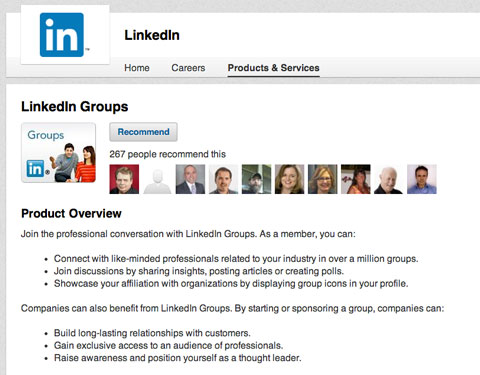Social media isn’t just about brand awareness.
When done right, it drives sales for your business.
Check this out: 23 percent of participants said they use social media for learning about products and services.
That means there’s a ton of growth for you in social media.
However, not every social media platform has the same audience. With so many platforms out there it’s important to invest in the right channels so you’re not spinning your wheels.
Follow these guidelines to get revenue from social media.
1. Use The Social Channel That Your Followers Use
The first step to driving sales using social media in 2019 is to figure out where your target customers are spending their time online, and use the same social channels that they use. A best practice for making the most of your time is to concentrate on a few key platforms, rather than using up precious resources building multiple accounts.
A best practice for making the most of your time is to concentrate on a few key platforms, rather than using up precious resources building multiple accounts.
This is how you go about it:
For one, conduct a thorough analysis of your target demographic. You can dig into the profile of your current customers, or try to find common characteristics of a target audience that you haven’t gotten in front of yet.
For example, you may be going through a rebrand and trying to sell to moms for the first time, or you could be currently marketing to students and trying to boost your online presence where they spend time.
Once you know who buys your products/services (or who you want to become a buyer), you should also know which platforms they use.
Though you can decide to be present on each social channel, remember that spreading your resources far too broadly and far too thin is time-consuming. In fact, such an action might do more harm than good.
A couple tips to keep in mind:
- Facebook is used by the most people, but it has lost favor with the younger crowd (between ages 18 and 29). If you’re skewing toward a millennial audience, you may want to focus your efforts on Instagram and Snapchat.
- Your target audience’s age does not necessarily tell you about their buying trends. Make sure that whatever audience you’ve picked, they are exhibiting buying behavior in the channels that they favor.
Bottom line: Being present in social platforms where your target audience is gives you a great opportunity to attain your goals.
If you can reach this audience in their native habitat while they are in the mindset to buy, then you increase your chances to drive sales.
2. Create Great Content But Don’t Make It Sound Salesy Or Pushy
While prioritizing on quality over quantity sounds obvious, most digital marketers still get it wrong. Social media users are very savvy. If you create mediocre content, you will not get the engagement you’re looking for.
Rather than dispatch a series of run-of-the-mill posts, spend the time creating a smaller amount of high-quality content. That way you’ll also be sharing your content at a pace that both you and your prospects can handle.
As you create content, do not make it sound too pushy or salesy. You must consider that social channels are not solely meant for buying and selling. The majority of people are still there to socialize virtually.
As one expert puts it:
“I encourage my clients not to focus so directly on sales when it comes to social, unless they’re driving an ad campaign with revenue-driven objectives. That’s not the point of social media, although it does happen often because of the role social plays in the consideration process.” – Chelsea McDonald, senior social media strategist at DEG Digital.
We’re not implying that social media cannot drive sales. Of course, it can. But your best bet for getting people to buy is to give them engaging and valuable content that makes them want to become your customer.
Here are a few suggestions for posts that achieve a good balance between salesy and helpful:
- Create images inspired by real-life situations
- Post pictures and videos that include recipes/tips for using your products
- Share images of prospects using or engaging with your products
3. Make It Easy For People To Buy On Social Channels
Pinterest’s Buyable Pins
In mid-2014, Pinterest introduced buyable pins. These pins are found in related pins, search results and even on an enterprise profile.
They were originally only available to a selected group of retailers. But nowadays any user can take advantage of this feature!
The prolonged shelf life of buyable pins, the great reach of re-pins and attractive aesthetics make Pinterest a powerhouse of social ecommerce. A combination of actionable and aspirational pins can boost product reach, maximize revenue and stimulate repeat purchases.
The best thing about buyable pins is that they allow customers to purchase products without leaving Pinterest, making the shopping experience frictionless.
Buyable Pins have an “Add to Bag” feature. This helps customers add their shipping as well as payment details without switching to a different platform. This is a very effective process because it allows for increased conversions instantly.
The other attractive feature of Buyable Pins relates to their functionality. They work seamlessly with both desktop and mobile platforms.
Pinterest’s Rich Pins
Rich Pins feature more details about a specific product, on top of a consistent pin. There are 4 different types of rich pins:
- Article
- Product
- App
- Recipe
Article pins let customers save stories that they think are more important to them than the rest.
Product pins make the buying process both intuitive and easy. They have features such as the location, availability, and pricing of a specific product.
App pins feature a one-click install button. This lets prospect simply download your app without leaving Pinterest. If you’re marketing a shopping app, this is a great way to get in front of potential customers. The only downside to app pins is they only work with iOS.
Recipe pins contain the information any food connoisseur would desire a pin to have. They feature serving size, ingredients, and cooking time.
Shoppable Posts on Instagram
Shoppable posts are a native integration that helps Instagram users tag products and shop them instantly from their organic newsfeed.
Shoppable Tags In Instagram Stories
Using Shoppable Tags in Instagram Stories, businesses can now tag physical products/services from their ecommerce platform or inventory.
Even brands with less than 10,000 fans can drive traffic to their products/services.
When a fan clicks on an item in your Instagram Story, they can view its description, price, and name.
4. Using Instagram To Generate Leads
Having an engaged Instagram audience is great, but converting them into leads is important!
Here’s how to combine Instagram features with effective calls to action to generate leads for your business.
Make Sure Your Instagram Profile Is Business-Ready And Properly Formatted
To generate leads on Instagram, you must connect your profile bio to a lead-generating landing page.
However, ensure your profile includes other major components:
- Explain why visitors should pay attention to your business
- Explain what you do and who you are
- Ensure you upload a quality profile image
Most importantly, your bio must have a value-added proposition if an audience clicks on your link. It should have a CTA (call to action) as well.
Include CTAs in Your Organic Posts
Creating attractive content in your feed posts is a great way to generate leads, too. To achieve lots of reach for a CTA feed post, encourage your active followers to share to their Instagram stories.
Share Instagram Stories To Generate Leads
The Swipe-Up Link on Instagram Stories drives viewers to a certain link. This is a sure way to generate leads using IG Stories. You can also include a CTA in your story posts.
5. Use LinkedIn For Brand Awareness
With LinkedIn, your business can establish strategic partnerships, generate leads and build awareness in the following ways:
LinkedIn Groups
One benefit of using LinkedIn is the capability to create a branded group. This group lets your business run a discussion board connected to your industry.
Moreso, it provides you a chance to create a community around your expertise, service or product. LinkedIn groups offer excellent visibility for a business, because your logo will be visible on each member’s profile.
Group owners can post various kinds of media such as images and videos, and instant notifications allow real-time conversations to take place much easier than before.
Currently, there are millions of LinkedIn groups. For yours to stand out, you must encourage your members to be active. For instance, let members post updates and articles so that other group members can benefit from them.
LinkedIn Programmatic Display Ads
With LinkedIn Display Ads, you can easily extend your current online display to LinkedIn. To do so, you can either buy display ads specifically via a private auction or add LinkedIn to your current programmatic buy.
Display Ads show in the right column of the LinkedIn desktop. Some advantages to consider vs. other social media advertising platforms:
- LinkedIn only shows a single ad for every page
- The ad is placed above the fold and has a viewability of more than 80 percent!
LinkedIn Sponsored InMail
Sponsored InMail is great for delivering private messages to target audiences at scale.
To raise brand awareness using LinkedIn Sponsored InMail, you must craft a great message. If you’re not sure how to do this, keep in mind that you can always hire an experienced copywriter to assist you.
Either way, note that Sponsored InMail is most effective for boosting brand awareness if used to share thought-leadership assets that add actual value to your customer.
We recommend that you use a personalized message from a thought-leader in your business or a relevant expert.
6. Paid Ads
Posting frequently to social media and replying to comments alone is not enough to drive sales. The most suitable strategy for making the most of your social accounts is via paid ads.
While organic reach on social channels goes on dropping, paid media helps you reach and boost your audiences quickly.
Every social media channel has advertising abilities. Facebook, for instance, features extensive targeting tools. This makes it really easy for businesses to develop successful campaigns.

Most importantly, the Facebook ads application lets businesses amplify posts to achieve any of these 4 objectives:
- Click-throughs
- Reach
- Impressions
- Engagement
Thus, your results can be customized depending on your goals.
Conclusion
I have covered some of the most effective strategies for driving sales using different social media channels (LinkedIn, Instagram, Facebook, etc.).
These methods involve having an active presence where your prospects are, and creating educational, optimized content without focusing solely on sales.
Further, the strategies involve simplifying the buying process, using Instagram to generate leads, using paid ads and using LinkedIn for brand awareness.
All these social media strategies aim at reducing friction and minimizing all the unnecessary steps that might hinder interested customers from buying.
Author Bio
Adina Jipa is Co-founder @ Socialinsider – a social media analytics tool which serves up a full view of a competitor’s digital strategy. I love writing about social media strategy and consumer behavior.

















